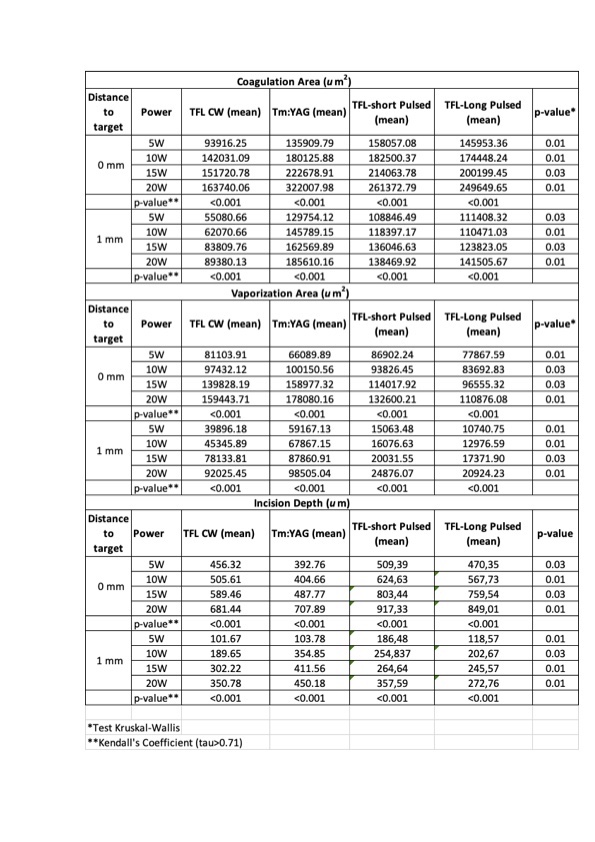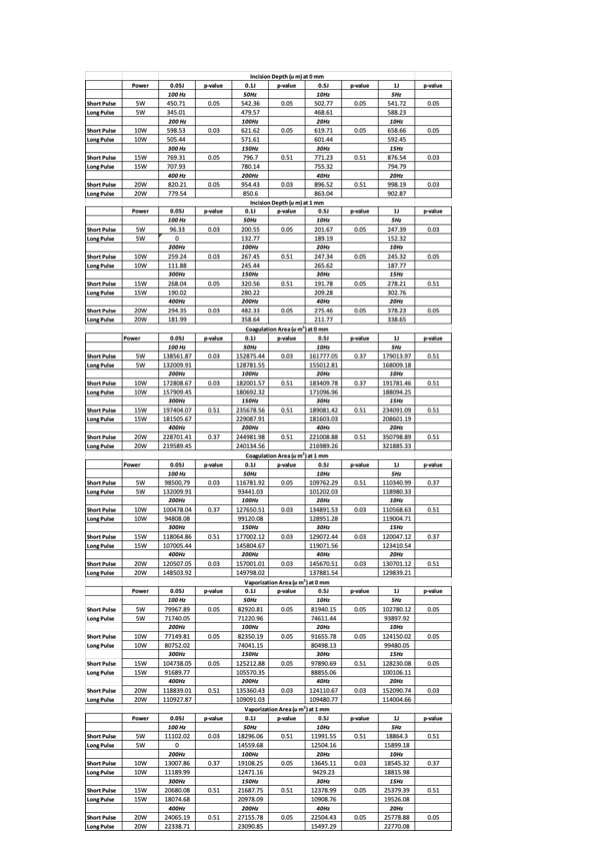Back
Poster, Podium & Video Sessions
Podium
PD37: Surgical Technology & Simulation: Instrumentation & Technology II
PD37-07: Thulium Fiber vs Thulium YAG laser effect on Upper Urinary Tract soft tissue: an ex vivo study
Sunday, May 15, 2022
8:00 AM – 8:10 AM
Location: Room 245
Luis Rico*, Silvia Proietti, Maria Pia Pavia, Milan, Italy, Leandro Blas, Buenos Aires, Argentina, Roberta Lucianò, Nazario Pio Tenace, Milan, Italy, Pablo Contreras, Buenos Aires, Argentina, Andrea Benedetto Galosi, Ancona, Italy, Franco Gaboardi, Guido Giusti, Milan, Italy
- LR
Podium Presenter(s)
Introduction: To date, there is a lack of evidence in terms of comparison of TFL and Tm:YAG laser on soft tissue.
The aim of this study was to compare soft tissue effects of these 2 lasers at various settings, with a focus on incision depth (ID), coagulation (CA) and vaporization areas (VA).
Methods: We performed an ex-vivo study in a porcine model.
The setup included a robotic arm that was holding the firing fiber laser while moving longitudinally, creating a fissure on the urothelium over a length of 1.5 cm.Two lasers were used: the 200W Tm:YAG (Cyber TM,Quanta System) in Continuous wave (CW) and the TFL laser (Fiber Dust,Quanta System) in CW and in Pulsed mode. The diameter of the laser fiber used was 272 mm in core.
Experiments were performed at a fiber-to-tissue working distance of 0 and 1 mm.
The emission Powers considered were 5,10,15,20 W.
For TFL in Pulsed mode, different settings for each power emission in Short Pulse (SP) and Long pulse (LP) modalities were evaluated:
0.05 J 100 Hz; 0.1 J 50 Hz; 0.5 J 10 Hz; 1 J 5 Hz
0.05 J 200 Hz; 0.1 J 100 Hz; 0.5 J 20 Hz; 1 J 10 Hz
0.05 J 300 Hz; 0.1 J 150 Hz; 0.5 J 30 Hz; 1 J 15 Hz
0.05 J 400 Hz; 0.1 J 200 Hz; 0.5 J 40 Hz; 1 J 20 Hz
Hystological examination was performed evaluating the following parameters: CA,VA,ID. Experiments and measurements were repeated 3 times for each setting.
Results: A total number of 240 experiments were performed.
Considering the same power, the mean ID was significantly deeper with pulsed TFL SP compared to the other laser/modalities at both distances (p < 0.05). The CA and VA were larger with Tm:YAG at both distances in the majority of powers considered (Table 1).
For each laser, higher is the power, deeper is the ID and greater are the VA and CA (p < 0.001).
TFL SP showed significantly deeper ID and larger CA and VA in the majority of settings compared to TFL LP (Table 2).
Conclusions: TFL seams to be an efficient alternative to Tm:YAG for soft tissue treatment.
Future in vivo studies are necessary to corroborate these findings.
Source of Funding: No Source of Funding


The aim of this study was to compare soft tissue effects of these 2 lasers at various settings, with a focus on incision depth (ID), coagulation (CA) and vaporization areas (VA).
Methods: We performed an ex-vivo study in a porcine model.
The setup included a robotic arm that was holding the firing fiber laser while moving longitudinally, creating a fissure on the urothelium over a length of 1.5 cm.Two lasers were used: the 200W Tm:YAG (Cyber TM,Quanta System) in Continuous wave (CW) and the TFL laser (Fiber Dust,Quanta System) in CW and in Pulsed mode. The diameter of the laser fiber used was 272 mm in core.
Experiments were performed at a fiber-to-tissue working distance of 0 and 1 mm.
The emission Powers considered were 5,10,15,20 W.
For TFL in Pulsed mode, different settings for each power emission in Short Pulse (SP) and Long pulse (LP) modalities were evaluated:
0.05 J 100 Hz; 0.1 J 50 Hz; 0.5 J 10 Hz; 1 J 5 Hz
0.05 J 200 Hz; 0.1 J 100 Hz; 0.5 J 20 Hz; 1 J 10 Hz
0.05 J 300 Hz; 0.1 J 150 Hz; 0.5 J 30 Hz; 1 J 15 Hz
0.05 J 400 Hz; 0.1 J 200 Hz; 0.5 J 40 Hz; 1 J 20 Hz
Hystological examination was performed evaluating the following parameters: CA,VA,ID. Experiments and measurements were repeated 3 times for each setting.
Results: A total number of 240 experiments were performed.
Considering the same power, the mean ID was significantly deeper with pulsed TFL SP compared to the other laser/modalities at both distances (p < 0.05). The CA and VA were larger with Tm:YAG at both distances in the majority of powers considered (Table 1).
For each laser, higher is the power, deeper is the ID and greater are the VA and CA (p < 0.001).
TFL SP showed significantly deeper ID and larger CA and VA in the majority of settings compared to TFL LP (Table 2).
Conclusions: TFL seams to be an efficient alternative to Tm:YAG for soft tissue treatment.
Future in vivo studies are necessary to corroborate these findings.
Source of Funding: No Source of Funding



.jpg)
.jpg)